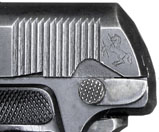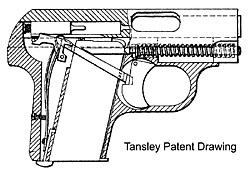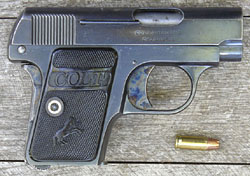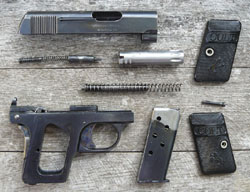 |
|||||||||||||||||||||||||||||||||||||||||||||||||||||||||||||||||||||||||||||||||||||||||||||||||||||||||||||||||||||||||||||||||||||||||||||||||||||||||
 |
|||||||||||||||||||||||||||||||||||||||||||||||||||||||||||||||||||||||||||||||||||||||||||||||||||||||||||||||||||||||||||||||||||||||||||||||||||||||||
|
The 1906 FN Browning and the 1908 Colt: by Ed Buffaloe On 7 July 1897 John Moses Browning and Fabrique Nationale (FN) signed an agreement giving FN the right to sell Browning-designed weapons in much of Europe, but specifically excluding them from markets in the United States, Great Britain, and Ireland where Colt’s had been licensed to sell Browning’s designs. The agreement was modified on 1 July 1912 to allow FN to sell Browning’s designs in Great Britain, Ireland, and Canada provided they paid a royalty fee to Colt’s for each gun sold. In turn, Colt’s received exclusive rights in North and Central America. The Cartridge John Browning asked William Morgan Thomas of the Union Metallic Cartridge Company (U.M.C.) to develop a new cartridge suitable for a small blowback operated vest pocket pistol. Thomas worked on the cartridge in 1903 and 1904. In June of 1904 Browning asked Thomas to manufacture 500 rounds for him to use in testing his prototype. The cartridge was introduced commercially in 1906 by FN, and has always been referred to in Europe as the 6.35mm Browning. The cartridge was introduced into the U.S. in 1908, where it is known as the .25 ACP (Automatic Colt Pistol). The FN Browning of 1906 Browning’s vest pocket pistol was essentially a miniaturized version of the Model 1903 with a striker to ignite the cartridge (in place of the hammer used in the earlier design) and with no manual safety. Browning offered the diminutive pistol to Colt’s as early as 1904, but they turned him down, so he took the design to FN, who manufactured it as the Pistolet Browning 6.35mm. FN received Browning’s prototype in 1905, and the first production pistols went on sale in July 1906.
For the second variant a manual safety lever was added. This change took place during 1909, but was not consistent--new slides with safety levers were installed in some guns with earlier serial numbers, while some guns with later serial numbers received older slides with no safety. Some say the safety lever was primarily intended to hold the slide open for field stripping the gun, and only secondarily served as a safety. However, the safety was patented by FN on 10 November 1906, only a few months after the pistol went on sale. In 1911, around serial number 220,000, the trigger was modified to have a larger front surface--it was given little flanges on either side, and was grooved in the center. According to Gangarosa, only about 30 ,000 of the second variant guns were made, making them relatively scarce. The third variant gun was known at the time as the “Triple Safety Model,” and is distinguished externally from the second variant by a slightly larger manual safety lever and different style slide detents. But the real internal difference was the addition of a magazine safety. I have not had the opportunity to examine a Model 1906 to determine how its magazine safety differs from the Tansley magazine safety on the Colt (see below). The Model 1906 was originally referred to by FN as “Pistolet Browning 6.35mm,” and sometimes as the “Modèle de Poche,” or pocket model. The gun was often popularly referred to as the “Baby Browning,” and when FN later created a new version they officially named it the “Baby Browning” and even put the word “Baby” on some of the early grips. Though it is often referred to as the “Model 1905,” after its patent date, “Model 1906” is the preferred designation for the older gun to distinguish it from the later official “Baby” model. Vanderlinden states that serial numbers had reached approximately 550,000 by the beginning of World War I in 1914. All production ceased during the war. Gangarosa states that, by the Summer of 1931, FN had reached serial number 1,000,000 in its Model 1906 line, at which point the new “Baby Browning.” was introduced. However, production of the Model 1906 continued, in much smaller quantities, through June of 1944. According to Vanderlinden, by the end of 1940, serial numbers had reached approximately 1,008,000. According to Gangarosa, a total of approximately 1,080,439 were produced through 1944. Special editions of the Model 1906 are known to have been made at the FN factory in very small quantities through 1959. Vanderlinden states that in his researches the highest recorded serial number is 1,311,256. The FN Model 1906 was issued in a standard polished blue finish with checkered animal horn grips with the FN logo in an oval at the top. Special order versions were available in six different levels of increasingly more elaborate engraving and gold inlay, most with either pearl or ivory grips. After 1940 standard grips were made of black plastic. The slide legend for the first year of production was in sans-serif characters as follows: FABRIQUE NATIONALE D’ARMES de GUERRE HERSTAL BELGIQUE From 1907 through much of the 1930’s the slide legend appeared in both serif or sans-serif characters, with the word “Depose” added, to indicate that the patent had been registered: FABRIQUE NATIONALE D’ARMES de GUERRE HERSTAL BELGIQUE or FABRIQUE NATIONALE D’ARMES DE GUERRE HERSTAL-BELGIQUE
Vanderlinden indicates that some minor variants of this inscription may exist.
The Colt Model 1908 Hammerless
In 1916 or 1917 a magazine safety, designed by George Tansley, was added somewhere near the 141,000 serial number range. Tansley was granted a patent for the magazine safety on 31 July 1917. The slide inscription was changed at approximately serial number 284,000 to read: COLT’S PT. F.A. MFG. CO. HARTFORD. CT. U.S.A.
There are a number of minor variations in the M1908, including width of the rear sight, size of the trigger, lettering variations, manual safety spring, trigger bar spring, and others. These are carefully detailed in Donald Simmons’ article “The Littlest Colt Automatic Pistol.” As early as 1920 Pollard wrote that the FN Browning “...lacks the better finish of the colt factory.” W.H.B. Smith states boldly that the Colt is better made than the FN. I wouldn’t hazard an opinion, since FN is well known for very high standards of production and I don’t have a Model 1906 for comparison purposes. However, there is no doubt that the Colt is extremely well made. It features color case hardening on the trigger, grip safety, and manual safety lever, and the overall fit and finish is superb. At the range, the Colt 1908 functioned flawlessly with both hard nose and hollow point ammunition. I was able to shoot pretty consistent three-inch groups at 25 feet. Field Stripping
|
|||||||||||||||||||||||||||||||||||||||||||||||||||||||||||||||||||||||||||||||||||||||||||||||||||||||||||||||||||||||||||||||||||||||||||||||||||||||||
|
Automatic Pistols, by H.B. Pollard. W.E., Greenwich, Connecticut. Reprint
of 1921 edition. |
|||||||||||||||||||||||||||||||||||||||||||||||||||||||||||||||||||||||||||||||||||||||||||||||||||||||||||||||||||||||||||||||||||||||||||||||||||||||||
|
Copyright 2008-2010 by Ed Buffaloe. All rights reserved. |
|||||||||||||||||||||||||||||||||||||||||||||||||||||||||||||||||||||||||||||||||||||||||||||||||||||||||||||||||||||||||||||||||||||||||||||||||||||||||
|
|
|||||||||||||||||||||||||||||||||||||||||||||||||||||||||||||||||||||||||||||||||||||||||||||||||||||||||||||||||||||||||||||||||||||||||||||||||||||||||
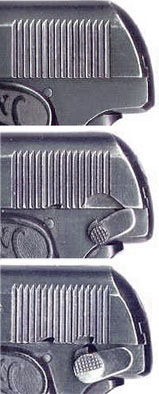 The
The 